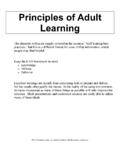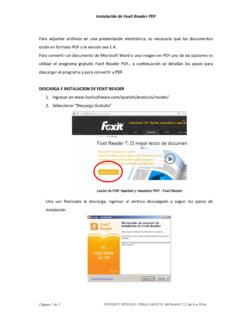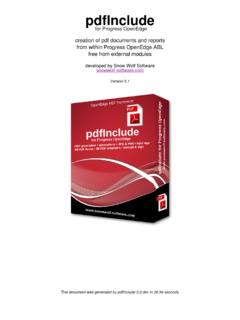Transcription of by Randall Grayson Teaching Archery
1 26 CAMPING MagazineMarch/April 1997 Teaching ArcheryGames, tips, and techniquesby Randall Graysonrcher y has been enjoyedfor centuries and can adda level of intrigue and ex-citement to any camp pro-gram. The key to a running a suc-cessful archer y program is to makeit as fun, and safe, as the right tool for the jobFirst, a brief note on are a few things every in-str uctor or potential instr uctorshould be aware of. Fiberglass bows,although cheap, should be avoidedbecause they are ex tremely inaccu-rate; they make it difficult or impos-sible to play some Archery games,and using them detracts from thefun of Archery , discouraging camp-ers from the recur ves either one pieceor takedown, which can be disas-sembled are the best bows to usein a camp program. Recurves havean indentation in the middle of thebow where an arrow rest is the ends of the bow, the limbstake a sharp turn bet ween 40 and80 degrees that yields greaterpower in a smaller form.
2 They alsohave a hand grip, which makes thebow easier to handle and lso, a smart archer never fails touse the proper safety shooting, make sure par-ticipants wear proper armguardsand finger protectors. A bowstringcan seriously injure an unprotectedarm, and blisters will eventually ap-pear without a finger up the rangenUse volleyball line and 6-inchgalvanized nails to make thefiring a waiting line 12 feet backfrom the firing the range is in the sun, placesun canopies over the firing lineand the waiting coffee cans at the targetdistances (15,20,25,30,40, and50 meters) so they re level withthe ground. This preparationmakes moving and replacingtargets much easier!nUse 48-inch target mats (foamor straw) and skirted, toughtarget faces. All tournamentsand national archer y guidelinesare based on this size. Also,your campers scores will go up10 points by using this size, asopposed to the 36-inch the targets 18 inches offthe most, schedule twice thenumber of campers as the archer y shack next tothe range.
3 Make a large windowon one side of the shack tohand equipment through. Postrules and hints on the inside ofthis window. When the windowis open, the rules can beviewed; when closed, they areprotected from the and their remediesDrawing back to differentpointsThe most common mistake camp-ers make is not consistently draw-ing back to exactly the same are t wo choices here: draw-ing under the chin or to the cornerof the mouth. A good way to illus-trate the latter is to grab the cornerof your mouth like a hooked fish (al-though the correct form is to justplace the index finger at the cor-ner). For the former, have campersimagine the string is going to splittheir noses and tell them to drawback without moving their that a properly an-chored shot will land on the markand a draw that is inch off thatpoint will land two to four ringsaway. A final technique is to bringthe campers to the target with anarrow and move the arrow aroundAMarch/April 1997 CAMPING Magazine27the target face, demonstrating thatsmall differences bet ween anchorpoints on their faces translate tolarge ones on the actual the shotAnother common mistake is totwang, or jerk, a shot, pulling thehand away from the face.
4 When thisproblem occurs, the camper drawsback to the appropriate spot, holds,and aims the shot only to releasethe string with a twang. The propermethod is to allow the string to slipoff the fingers without moving thehand at all, or to have the hand fallback to the shoulder naturally. Dem-onstrate the disastrous effects of thismistake by sinking a shot in thebull s-eye and then purposely twang-ing a shot and having the arrow missthe mark or even the whole proper method to hold anddraw the string is to use three fin-gers. One finger rests on top of thearrow nock and the other two restbelow, with the string on the tips ofthe fingers no farther back thanthe fingertip mound. The instr uctorcan demonstrate that holding thestring farther back on the fingersresults in an automatic t wang as thefingers uncurl to release. Also, ifcampers squeeze the arrow betweentheir fingers or curl their fingersaround the string, the arrow willlikely fall off the arrow positionCampers often make the mistakeof not standing sideways on the firingline; the correct position causes anarrow placed against the toes to pointstraight toward the bull s-eye.
5 Demon-strate the importance of this positionby dropping one foot back and hav-ing the shot land lower and to the tip movementArrow tip movement at full drawis something to examine closely, es-pecially with more advanced ar-chers. Small body movements, suchas squeezing the shoulder blades,will make the tip of the arrow moveback and forth from inch to 2inches. The result is a looser patternof arrows on the campers be successfulIt often helps to coach campersby simply standing by them and say-ing aloud, Draw .. hold .. aim ..clean release. However, this tech-nique isn t ver y effective for a camper is having trouble withaiming, tr y handing him an arrowwithout a bow and ask ing him to restit on his fist as i f at full draw. Thenask him to aim the tip of the arrowat different things on the is important to impress uponcampers not to change their aimingpoint ever y time an arrow lands out-side the bull s-eye! Instruct campersto change their point of aim only i fthree arrows land in roughly thesame undesired location.
6 For mostarchers, the point of ai m is to theright of the bull s-eye. Beyond that,(continued on page 28)Starting Out Right: A ChecklistBowsType and numberFor a camp population of 7- to 16-year-olds, the following distribution ofbows is appropriate for a range with eight targets: three 20# RH, one 20# LH,four 25# RH, one 25# LH, three 30# RH, one 30# LH. If your camp usesdistances greater than 30 meters for target Archery , I also recommend two35# RH and one 35# suggest the following set up for bows: saber plastic arrow rests with the L holder, a 14-16 strand double looped string for wood arrows (helps keepthem on the string) and 12 strand for fiberglass or aluminum arrows, andstring nocs appropriately positioned. These terms may sound foreign, but yourarchery supplier will know exactly what they of wearnsplinters in the woodndamage to the bowstringnloose or missing serving (serving is the thread wrapped around themiddle and ends of the string)nbent limbs (hold one limb out at arm s length and sight down the lengthof the bow at the other limb).
7 If it is bent or leaninga little, you can try straightening it by applying pressure in the otherdirection. If a limb is bent more than 15 degrees, discard the rests in bad shapeTarget matsFor styrofoam targets, shoot an arrow into the target from 15 meters. If thearrow sinks more than halfway, it s time for a new target mat. Consider using adrywall saw and replaceable target centers. If the targets are straw, discardthem if arrows shot from 15 meters sink in more than one-third of the itemsnarchery gluenmasking tapenarrow nocsnpostersnarrow restsnsafety equipmentnballoonsnstring nocsnbow square for puttingnstring noc plierson arrow rests and string nocsnstring waxnbowstringsntarget facesnfletchingsntarget staplesnfletching jig to replace feathersntennis hunting bluntsnwhistle28 CAMPING MagazineMarch/April 1997it will be lower or higher dependingon the archer s height, the bowweight, and her draw are of ten discouragedwith Archery because it requirespatience to excel.
8 Tell campers toexpect that they will not even hit thetarget with their preliminar y them that it will likely takethem two or three sessions beforethey can hit the target somewhatconsistently. If they do h it the tar-get, they will be thrilled!Finally, videotaping campers sothey can see their mistakes is an ef-fective method of fixing short haulIf campers are only going tospend a few periods at archer y andwill not have a chance to specialize,emphasize fun over the targets up to 10 and 15meters for young or inexperiencedarchers. Place balloons or otheritems on the targets after half theperiod is up. Tr y some archer ygames. Finally, let the campers shootas much as possible in the short timethey are there. Provide several in-structors so safety isn t compro-mised, and tr y and allow eachcamper to shoot roughly 24 arrows(four rounds of six) in each gamesGolfYup, golf! You need a large, whollydeserted area for this game.
9 Fill 55-gallon, heav y-duty trash bags withhay and seal with duct tape. Spraypaint the bags f lorescent about nine around a large field,laying the field out like a real golfcourse. Var y the distances of the bags(holes) between 75 and 300 metersand place obstructions so that camp-ers will sometimes have to shoot froma certain angle to sink an arrow. Alost arrow counts as a stroke features of the fairway mayconstitute sand traps or obstacles use your imagination. Fore!SoccerYou ll need hunting blunts,wooden arrows (so you don t destroythe ball), and a playground ball. (Asoccer ball is too heav y and toohard.) The playing field should mea-sure about 40 meters by 20 of five work well, althoughmore people can be included. Eachteam member gets t wo blunted ar-rows and a team stands at its goal line;the ball is in the middle of the play-ing field. A ll the firing archers standon a make-believe firing line whilethe other team stands behind idea is to hit the ball with theblunted arrows and nudge it acrossthe other team s goal line.
10 A fter thefirst team shoots, the other teamtakes up position on its goal line,with the first team now standingbehind them. Caution: If the ball iscloser than 15 meters, do not allowthe shot. The arrows can reboundalmost that , launch an arrow as far aspossible. For this activity, I recom-mend a 50- by 200-meter area. Thisactivity is especially fun when all thegroup members fire at the same , the utmost confidence in thesafety of this extended range needsto be present no people, activities,or structures any where to f light, except a woodpole is sunk about 75 to 100 metersout. Tie a rope to the base of the poleand mark off 3 feet on the rope foreach color of the target white, black,blue, red, yellow. The idea is to get asclose to the pole as possible. If a largearea is not available, this game can beplayed using flu-f lu arrows and a 40-meter range. Flu-f lu arrows have enor-mous feathers on them that slow thef light and limit the range to between30 and 40 Games continued from page 27 March/April 1997 CAMPING Magazine29 Pin up target shootingCandy shoot: Place some candyin balloons.











